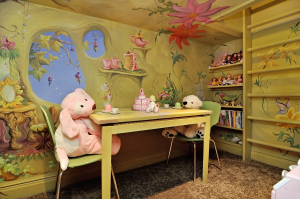By Peter Ricci

GVP stresses that homeowners unique lifestyles be reflected in their custom homes. Pictured is a secret playhouse GVP constructed for one client.
Luxury homes offer homebuyers a seemingly limitless number of choices; so much choice, though, can potentially be overwhelming for the Realtor, builder, and client alike. To explain the luxury home design/build process, Chicago Agent spoke with Peter and Erick Grahn, co-founders of luxury design/build company GVP Development, about 7 points Realtors should be mindful of while guiding clients through the design/build process.
Approximate what the land can support
Before any plans can be drawn up, the land must be properly evaluated. What can the land handle? What types of homes and what types of designs are possible with the provided land? Those are the questions, Peter said, that must be answered before any design templates are created. Additionally, clients may not always have land on-hand, and in that case, Peter said they often work closely with Jennifer Ames, a Chicago Realtor who recommends exceptional land opportunities.
Effectively balance client needs and wants
After the land is assessed, conduct thorough discussions with the client about the wants and needs of the property. “What do they have to have?” Peter asked. “Do they need four bedrooms on the second floor? Do they need a media room, or want a media room? It’s a balance between needs and wants.” A common want, Peter said, is the attached garage. “Every single new buyer wants an attached garage, and it’s oftentimes very difficult to get it to happen,” Peter said. “Oftentimes, you can’t get everything you want, either because the lot constrains you, or your budget constrains you. So, it’s just a combination of balancing those things out.”
Develop the details of the property during construction
Once the vision of the property is agreed upon and foundational construction begins, discuss more specific details with the client. “The front end is the design of the house and the façade, and then you’re picking out the finished details as you go,” Peter said.
Be flexible
Allow for minor alterations to those details as construction continues, should the client change his or her mind. “Oftentimes, Erick will walk through with clients in their house, and once it gets built, (they say) ‘Oh wow, it seems a little tighter than I thought,’ (and) you move a wall a little bit here or there,” Peter said, with Erick adding that other common tweaks include styles of tile, carpeting and other details.
Design in Harmony
Design specific components of the house to match the rest of the property. “Does (the design) stylistically match the rest of the house?” Erick asked, to which Peter added, “How does it work with the crown in the room, (or) the ceiling detail in the room? And sometimes, there’s furniture in the room.” Regardless of the object in question, continuity and harmony should be the ultimate objective of the project.
Proper living accommodations
Through all the details and flourishes, never lose sight of the fact that someone will be living in the house being constructed. “You really get in to how (the clients) live when you design the kitchen,” Erick said. “Are they going to eat in the kitchen? How old are the kids? A kitchen is such a central focus of the house.”
Keep in constant contact with the client
Never leave your client in the dark about how construction is progressing, but rather, keep them as informed as you possibly can. “We’re in contact with (our clients) multiple times a day,” Erick said. “We facilitate all the decision making processes with them, (such as) assisting them in selecting tile, cabinets (and) trim work.”
Approach the project with a “real estate driven” mindset
A beautiful, unique home is one thing, but a luxury home that can sell is an entirely different matter, and a custom home should always be built to sell. “You don’t want a five-bedroom house with two bathrooms,” Erick said. “You have to encourage that it has re-salability.”
Don’t go overboard with customizations
Italian tile, custom trim work, coffered ceilings – such details make a customhouse, but use moderation when applying them. “You’ve got to think about the whole feel of the house, rather than just take all of the trends that are out there and employing them into the house,” Erick said, who commented later how during the housing boom, clients often overdid details (such as wanting coffered ceilings in every room in the house), which in turn hurt the home’s resale value because of the “obnoxious” customizations, as Erick said.
An extension of uniqueness
Finally, ensure that the clients’ custom home properly reflects the unique qualities of the clients themselves – how they live, play and interact. “It’s a different puzzle for each house, because everyone has different wants, needs, requirements and lifestyles,” Peter said. Erick offered a particularly fascinating example of a past client who asked GVP to convert the walk-in closet of his daughters’ bedroom into a secret clubhouse. The end result, Peter said, was like something out of “Batman”: the door to the closet was reduced in size and hidden by a bookcase, which swung open to reveal a peg-board staircase that led to a carpeted loft with a window and a mural. Other, less endearing examples included a basketball court that the clients requested – on the roof of the house. “The thing is, the ball goes over the side, it drops four stories!” Peter said.

A great article in better understanding the home construction process. Very interesting and informative!